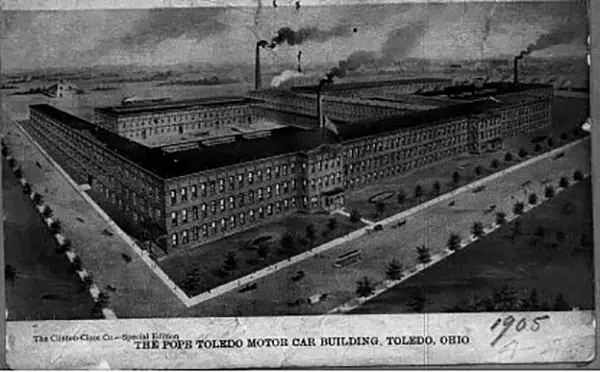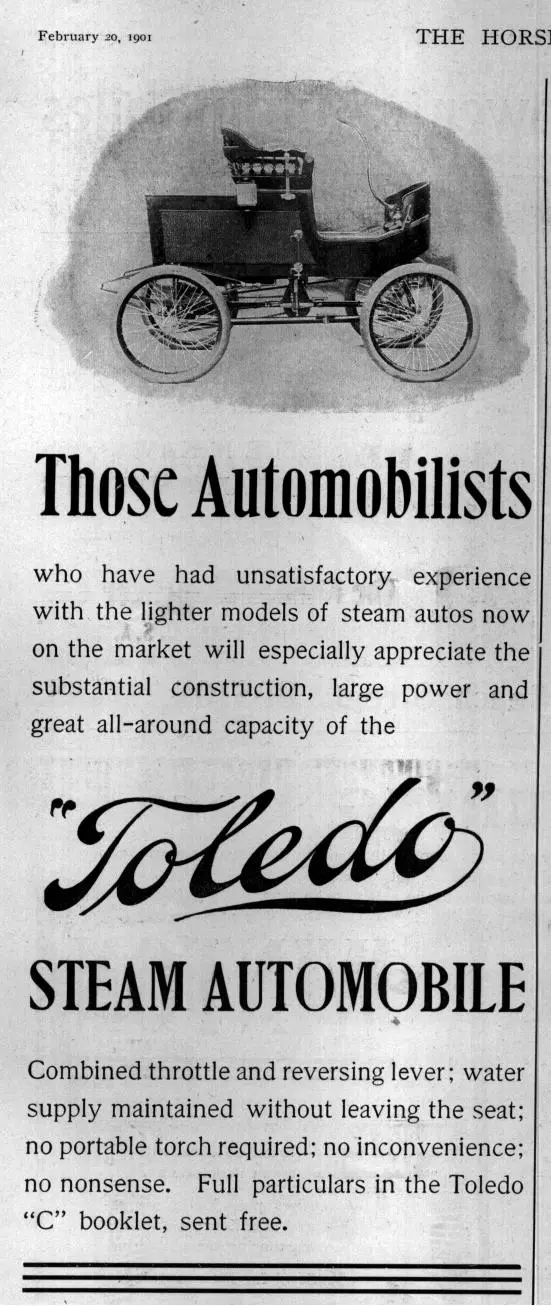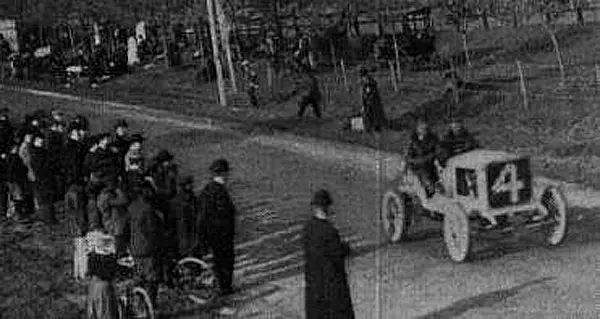by Timothy Messer-Kruse, December 1999
The Pope Toledo Motor Car Building, Toledo, Ohio, 1905
Toledo has had a long and continuous automotive history. For Toledo, the year 2000 will not only mark the great roll-over of the millennial odometer, but will also be the centennial year of automobile production in the city. In the fall of 1900, the American Bicycle Company built a steam truck in a factory on Central Avenue. From that time with only a few interruptions, notably in the panic of 1907 and the Great Depression, automobiles and trucks have been built upon this same site to the present day.
Toledo's automobile industry had humble beginnings. A number of tinkerers began working on horseless carriages in the late 1890s. In 1898, a Toledo plumber by the name of A.E. Lecklider began construction of an automobile in his spare time. He completed it in 1902 but saw it destroyed by fire the following year. In 1899, George Burwell, superintendent of the Lozier Bicycle factory, designed a 3 wheeled gasoline car with John G. Perrin, though it is not known if the contraption was ever made. Burwell would be the first Toledoan to patent an automobile part when his engine cylinder lubricator was recognized in September of 1900 [open]. A Toledo bicycle company, Kirk Manufacturing, announced that it was working on an automobile in 1899. Another inventor, Alfred Thompson, patented an automobile design in 1901 [open]. Though no automobiles were actually built in Toledo until late in 1900, a number of them were seen on the streets before then (Peter Gendron drove one in 1899).
In May of 1900, Toledoans were disappointed to learn that the Lozier Motor Company, a maker of bicycles and marine motors, was leaving Toledo and moving to New York state. After several months of negotiations, the American Bicycle Company (ABC), one of the many companies owned by the Hartford, Connecticut industrialist Albert Pope, purchased the Lozier factory lock, stock and barrel. Pope was just beginning to diversify into the infant automotive industry and began gobbling up auto patents and properties. In addition to the Lozier properties, Pope purchased an electric automobile plant in Massachusetts.
ABC wasted no time in tooling up its Toledo plant and sometime before December of 1900, it built a 925-pound, two-seat steam carriage. Reflecting the industrial base of the city and company that built it, the steamer incorporated many features of the bicycle (over the previous decade, Toledo had been one of the largest producers of bicycles and bicycle parts in the nation). Toledo Steamers sported bicycle spoke wheels and bicycle tube frames, making them easy to spot from a distance in a faded photograph. By February of 1901, ABC was advertising its little Steamer for sale around the country.
At the time, most automobiles were powered by steam or electricity. Internal combustion was a far trickier technology in those early years as combustion engines were more expensive, less reliable, and more prone to breakdowns. Steamers worked by burning gasoline or kerosene to boil water. The resulting steam pushed one or two pistons that cranked a belt or chain drive to the rear wheels.
Toledo's Steamers boasted an improved boiler that was more efficient and used less gasoline. But like electric cars, Steamers’ prospects were doomed by their limited range. Electrics needed a new charge after fifty or sixty miles, and Steamers needed to replenish their water supply. Even Toledo's better boilers sucked a gallon of water for every mile traveled. The Toledo Steamer’s 35-gallon gas tank and 9.5- gallon gas tank could only propel the little carriage 36 miles.
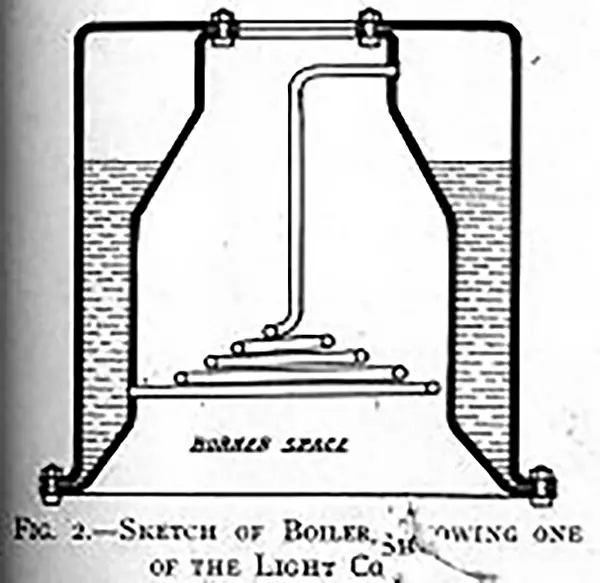 Sketch of boiler
Sketch of boiler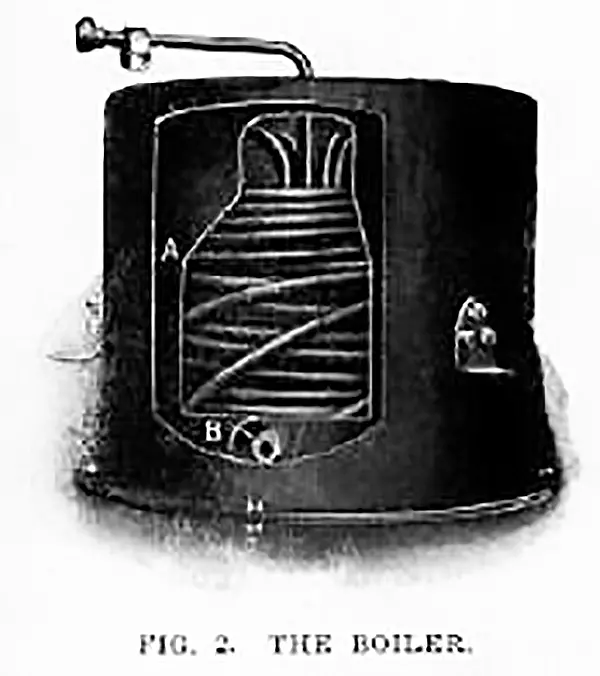 Automobile boiler
Automobile boiler
Driving early vehicles was dangerous. There were numerous valves, levers, and other controls that, if not set in their proper sequences, could send the car careening out of control. One unfortunate country doctor confused some levers when starting his Steamer, with the following result:
Thus given life and liberty the carriage gave a lunge, and throwing my frightened friend out on his head, made for the nearest house, which it bombarded with such a crash that the inmates thought the tenants of Dante's Inferno were let loose. The concussion threw back the reversing lever and away the vehicle went, like a pyrotechnic serpent, in the opposite direction, and fetching up against a portico made kindling wood of the greater part of it. Seemingly satisfied with its antics, it rebounded into the road, where it came to an unexpected standstill. It seems the last concussion had fortunately thrown the reversing lever to dead centre; hence the cessation of hostilities. We finally got in and returned home.
Difficult to operate in good conditions, the Steamer was often rendered useless in windy or cold conditions. Water lines froze, gas did not vaporize equally, and a good wind could snuff out the burner completely [open]. Dedicated drivers hired mechanics to travel with them and most found they had to fashion parts and modifications to keep their vehicles on the road. Getting a good head of steam up in a cold engine was an arduous task [open]. ´After a couple of hours I finally succeeded in getting the required amount of steam," wrote one novice driver, "but not until I had scorched my eyebrows and hands somewhat. . .”[open]
By September of 1901, two separate models of Toledo Steamers were entered in the first long- distance endurance road rally in U.S. history, from New York to Buffalo [open]. Although the race was cancelled en route due to the news that President William McKinley had been assassinated, a 6.5 hp Toledo, driven by H. Curtis and Grant Rollings, finished the race and earned a third-class certificate after averaging a whopping 4.21 mph. Pleased by Toledo's prospects, ABC announced a few months later that it was moving the headquarters of its automobile division from New York to Toledo and expanding its factory by a third.
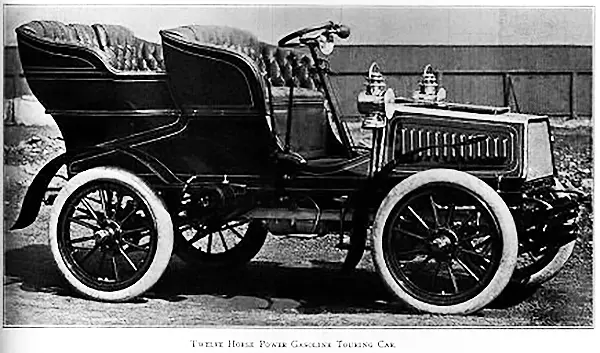 12 HP Toledo Gasoline Touring Car.
12 HP Toledo Gasoline Touring Car.
ABC debuted its new line of Toledo Steamers at the Madison Square Garden Auto Show in New York in 1901. Not only did it buy the largest space of any exhibitor at the show, but it conducted a number of publicity stunts. The company drove one of its carriages from Toledo to New York to attend the show. The trip took two weeks. Each day the drivers composed a tale of their adventures and progress and telegraphed it to New York, where they were posted by ABC's exhibit. To show off the rugged construction of its engine, a working model was to be installed at the show and revved up to a screaming 2200 rpms before suddenly engaging the reverse gear. The advertising paid off: trade journals gave the new cars much praise, especially those tortured engines that the leading automobile journal said were "put up in a very substantial and workmanlike manner" [open]
In 1902, the American Bicycle Company divested itself of its last bicycle holdings and changed its name to the International Motor Car Company. That same year, the Toledo plant began building its first internal combustion touring car, though it also continued to produce a line of Steamers. By the following year, however, the company abandoned the Steamer and began producing gas cars exclusively.
The gasoline engine, producing far more horsepower per pound of powerplant and enjoying a much larger range, also allowed for a bigger and heavier chassis. In 1903, the newly renamed ´Pope-Toledo´ took on its classic look - a sturdy, ruggedly built, open roadster with high, overstuffed seats. It was a luxury car popular among the country club set with a base price of nearly $3,000, several times the yearly income of most Americans. When Secretary of State Elihu Root needed automobiles to carry Russian and Japanese diplomats around Portsmouth, New Hampshire, during the important negotiations that ended the Russo-Japanese War, he ordered a dozen Pope-Toledos.
The heavier, more powerful Pope-Toledo also began to distinguish itself in the world of racing. In 1903, the Pope-Toledo won fifteen races and placed in twenty-nine others. The following year, Pope-Toledos made it to the winner's circle in thirty-three of the forty races they were driven in. It also became the first gasoline auto to climb Mt. Washington, the tallest peak east of the Mississippi.
The success of the Pope-Toledo soon encouraged imitation, and a pair of rival Toledo bicycle companies combined to give the Pope corporation a little competition. The Snell Fittings Company (perhaps the largest maker of bicycle parts in the U.S.) and the Kirk Manufacturing Company debuted their ´Yale´ automobile in in 1903. The Yale was produced for less than two years before the project was abandoned.

